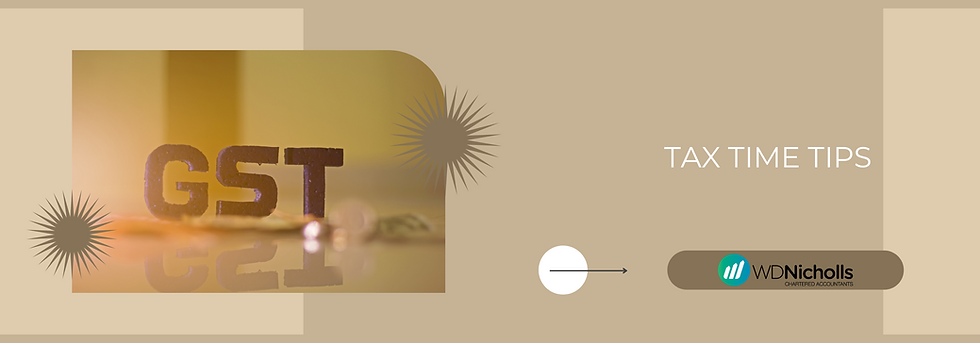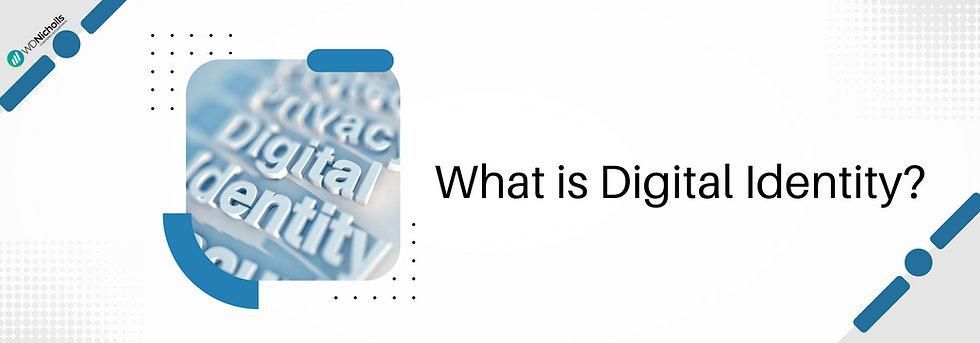Update 1 August 2022
- WD Nicholls Chartered Accountants
- Aug 3, 2022
- 7 min read
Updated: Jul 8, 2023

This month our Financial Planning Expert, Tony Marshall talks about removal of the Work Test over the age of 67. There has been an increase to the Super Guarantee. The First Home Super Saver Scheme (FHSSS) has seen a positive change for buyers. Income thresholds legislation has now passed for the Commonweath Seniors Health Card and we will take a look at the market.
Now that we are into the new Financial year, we have some GST Tax Time Tips that will ensure you are prepared for the year ahead.
Did you know about Digital identity? It provides Australian people and businesses with a single, secure way to access government and other services online. There are some changes for business that are important to check.
What is a Taxable payments annual report (TPAR)? Find out about the TPAR 3 steps and how these changes affect payments to your business and contractors.
The Export Markets Delivery Grant (EMDG) program provides funding to help businesses market and promote their goods and services internationally. Grant applications close in 19 days.
The WD Nicholls Team

As a slight change of pace this month I thought it is prudent to re-look at superannuation and some legislative changes that occurred earlier in the year and now.
Removal of the Work Test
As of 1 July 2022, the government removed the work test for persons over the age of 67. As a result, it is now possible for any person under the age of 75 to contribute additional funds into superannuation as a non-concessional contribution. This change in legislation has opened up many strategies for clients with respect to the breakdown of their super. It allows clients to contribute additional funds into super to assist in wealth accumulation if they are looking to increase their allocation to growth assets. You will also be able to use the bring forward non-concessional contribution rule.
*Disclaimer Now we all know it isn’t that easy because you have to be wary of the Transfer Balance Cap ($1.7 million) and other legislative restrictions. So you will always need to seek advice if you are looking at the above.
Claiming a tax deduction on contributions
Not much has changed here. You are still able to claim a tax deduction on personal contributions up until the age of 67, however, if you wish to do this after the age of 67 you need to have met the work test (40 hours of work in a consecutive 30 day period).
Super Guarantee Increase
For all those workers out there the Super Guarantee percentage rate increased to 10.5%.
First Home Super Saver Scheme
There have been changes to the FHSSS. In summary, from 1 July 2017 up to $15,000 of voluntary contributions per year could be made but you were only able to withdraw $30,000 to fund the purchase of your first home. From 1 July 2022 a total of $50,000 may be released from the scheme. The annual contribution limit remains at $15,000.
Deeming Rate Freeze
The government has confirmed they will freeze the Centrelink Deeming rates until 30 June 2024. They have indexed the deeming threshold as well:

Commonwealth Seniors Health Care Card
Legislation has been released to increase the income thresholds for the eligibility of the CSHCC. These thresholds will increase as follows:

Markets
Without sounding like a recording of the last few month's articles I am giving inflation, rising interest rates etc a rest this month. However, markets have taken a pause from the negativity over the past 6 months:


When you're doing your tax this year, why not use the time to check your GST? Here's the ATO's recommended list of GST items to check.
Your GST registration
You may need to register if you're approaching the threshold or cancel if you no longer need to be registered.
Any outstanding business activity statements (BAS)
They'll need to be lodged before you lodge your tax return, so your tax assessment includes the pay as you go and GST instalments you've paid throughout the year.
Any missed GST credits
It's a good time to check if you have missed claiming any GST credits. Your entitlement to a GST credit ends four years after the due date of the earliest BAS in which you could have claimed the credit.
The accounting method you use to report
It's a good time to re-evaluate if it's right for your business needs. You can change at the start of a new tax period.
When you're lodging your tax return, remember:
if you're entitled to GST credits, a deduction for your business should be the amount of the purchase less any GST credits
if you're not entitled to GST credits, you can claim the full cost of a business purchase, including any GST, as a deduction.
See more
Registering for GST
Claiming-GST-credits
Choosing an accounting method for GST
BAS and GST tips
Source and credit: ATO.gov.au

Digital Identity provides Australian people and businesses with a single, secure way to access government and other services online.
The Digital Identity System provides additional privacy and security assurances for you, with strict protocols in place to keep your information secure and stop it from being collected, profiled, used or sold for other purposes. The service you’re accessing won’t know which Digital Identity you’re using, and the Digital Identity you’re using won’t know which service you’re accessing.
If you’ve already set up your myGovID you can continue to use it as your Digital Identity to access other government online services, saving you from having to prove who you are over and over. Your Digital Identity will continue to provide a safe, secure and convenient way for you to prove who you are online.
What’s changing for businesses?
You’ll notice a few minor changes to the login process for online services for business such as:
the Business Registration Service
IP Australia’s online services
the R&D Tax Incentive customer portal
the Franchise Disclosure Register.
The login button for these services now display ‘Continue with Digital Identity’ replacing the ‘Login with myGovID’ button.
When you select ‘Continue with Digital Identity’ you’ll be given the option to select myGovID as your Digital Identity and asked to provide consent to share your information.
Other government services will be transitioning to the Digital Identity System over the coming months.
Learn more about your Digital Identity.
Source and credit: Business.gov.au

You may need to lodge a Taxable payments annual report (TPAR) by 28 August if your business pays contractors to provide the following services:
building and construction
cleaning
courier services
road freight
information technology
security, investigation or surveillance.
Doing your TPAR involves three steps:
Prepare – work out if you need to report. Due to COVID-19, you may have contracted out more services in the past year, for example cleaning or delivery, and so you may need to lodge a TPAR.
Record – check you’re keeping the right records, such as total payments made to each contractor for services. This includes cash payments.
Report – lodge your TPAR online by the 28 August due date. To make it easier for contractors to prepare their tax returns, the ATO has included the payments reported in the TPAR in their prefilling service.
The ATO are making this information visible to the community through their new Reported transactions service. This means that small businesses can now access and view the Taxable payment reporting system data held through ATO online services.
Find out more
Taxable payments annual report (TPAR)
Reported transactions in ATO online
Source and credit: ATO.gov.au

The Export Market Development Grants (EMDG) program provides funding to help businesses market and promote their goods and services internationally.
Closes in 19 days
Closing date:17 August 2022
What do you get?
Funding amounts vary.
Who is this for?
Australian exporters.
Overview
EMDG is an eligibility-based, demand-driven program. This means all eligible applicants receive a grant from the available funds. The grant amount depends on the:
number of eligible applications in the round
available program budget to be shared among all eligible applicants.
Small to medium exporting businesses can apply for 3 different grants over 8 years (not necessarily consecutively) for eligible promotional activities.
Grants are available in 3 tiers, designed to provide different levels of support to you during different stages of your export journey:
Tier 1: Ready to export
are ready to export in the grant year
have not exported before
have appropriate skills in marketing eligible products in a foreign country.
Grants agreements are offered for up to 2 years.
Tier 2: Exporting and expanding
exporting eligible products
seeking to expand export promotion activity for eligible products.
Grant agreements are for up to 3 years.
Tier 3: Exporting, expanding and strategic shift
exporting eligible products
seeking to expand export promotion activity
ready to make a strategic shift in the marketing of eligible products in a foreign country.
Grant agreements are for up to 3 years.
Assistance for industry bodies and alliances extends to training members to become export ready.
Representative bodies will continue to have access to financial assistance for promotional activities on behalf of their members in international markets. Grant agreements are for up to 3 years.
What is provided in the EMDG grant for expenses in one or more of the following categories:
maintaining a representative in a foreign country
short trips to a foreign country
engaging a consultant to undertake research or promotional activities
short trips within Australia
foreign buyer visits
soliciting for business in foreign country
providing free samples
producing and providing promotional and advertising material
intellectual property rights
if you are a Tier 1 applicant, obtaining export readiness training.
Grant amounts
The final grant amounts after all applications are assessed are determined based on:
the number of eligible applications received in that round, and
the total funding available, i.e. the grant pool is spread across all applicants.
The grant amounts in the first round in financial year 2022–23 may be useful as a guide:
Tier 1 – up to $15,000 per financial year
Tier 2 – up to $24,600 per financial year
Tier 3 – up to $36,600 per financial year
Representative bodies – up to $90,000 per financial year.
What are the eligibility criteria?
Eligibility requirements include:
your turnover for the financial year before the financial year in which the application is made is less than $20 million
you must be an Australian person as per the EMDG Rules 2021
you must have an Australian business number (ABN).
EMDG grant funds must be used for:
promotional activities to market eligible products in foreign countries, or
for training activities to develop skills in marketing for this purpose.
To be eligible, a product must be of substantially Australian origin and be one of the following:
goods
services
events
intellectual property or know-how
software.
How do you apply?
You can find out more about eligibility and how to apply via the link below.
Source and credit: Business.gov.au

If you wish to arrange a telephone appointment or zoom meeting with one of our team please contact our office either by telephone or email.
15 Aug 2022 PAYG withholding annual report due
22 Aug 2022 July monthly BAS due
29 Aug 2022 Taxable payments annual report and June quarter SG charge statement due












Comments